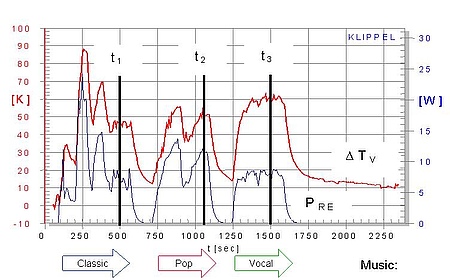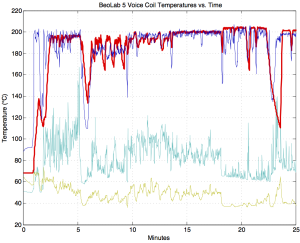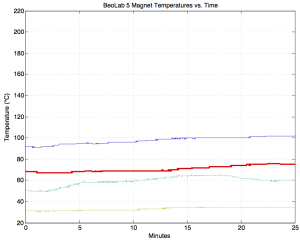If the listener burns in the speaker at home, they get to listen to the speaker's S.Q. slowly improve over time, and that could be a pleasant experience in its own right.Are you kidding?
It is! -Electricity, the actual spare real estate for this, heating. It's money right out of the window (FOR THE OWNERS!) regardless the pricetag in the speaker. The owners would rather have that money spent by their own hands.
-
WANTED: Happy members who like to discuss audio and other topics related to our interest. Desire to learn and share knowledge of science required. There are many reviews of audio hardware and expert members to help answer your questions. Click here to have your audio equipment measured for free!
You are using an out of date browser. It may not display this or other websites correctly.
You should upgrade or use an alternative browser.
You should upgrade or use an alternative browser.
Do Audio Speakers Break-in?
- Thread starter amirm
- Start date
D
Deleted member 48726
Guest
I've provided evidence. Look at it. It's not patronizing. I can tell you haven't so it was a well meant advice.Bold answer, but you don’t show any proof. Whoever claim the breakin is real just say “it sounds better” but that is a personal opinion.
I personally have owned dozen of speakers/headphones in my life, I never saw any magical change after either 20 hours or 200 hours (that is my earlier sarcasm, it looks like there is no consensus on the duration of the breakin interval, just “good” numbers like 100, never 121) but I don’t use it as a “proof”, I just read the results of the tests (like @amirm did in this conversation), there are not many of them (it is not easy to do) but all show that the change in speaker parameters is away below the human perception. The parameters change much more depending on humidity and temperature, because the speaker suspension is made with rubber, and the rubber elasticity depends on the environment. And even in this case, there is no evidence that the change is audible. When I buy an elastic band, it is good to use just out of the box, there is no warning on the box label that warn me to stretch the band for some amount of time before using it.
You tell me to go and read the thread, another way to patronize the other people, who tells you that I didn’t. @amirm did a good job on his test, it is now up to you to show the opposite, but with a scientific experiment, not with bold claims or that the audio manufacturers say so. Audio manufacturers make a lot of claims just for marketing reasons. And there are also manufactures that don’t believe in breakin at all.

Knowledge base
en-us.sennheiser.com
I won't comment on your elastic bands. What an argument..
Haven't read much of this thread, so pls pardon if this has already been said...(probably many times?)
While it's easy for me to agree that speaker break-in audibility is close to pure myth,
there is no question large drivers suspensions loosen up some in the first few hours of operation.
Most DIY sub builders know that large drivers' free air resonant frequency lowers some after initial strong use.
It's important to make sure that has occured, for either correct acoustic modeling, or real world adjustments of port sizes & lengths, etc.
I've measured port tuning frequency lower as 18" drivers break-in.
When it comes to wear over time, apart from suspensions loosening/deteriorating, the issue of cone sag exists, especially for heavy voice coils in drivers mounted horizontally.
My take is that this 'coil decentering' takes away a little bit of the clean dynamic peak capability....but that's just a gut call.
While it's easy for me to agree that speaker break-in audibility is close to pure myth,
there is no question large drivers suspensions loosen up some in the first few hours of operation.
Most DIY sub builders know that large drivers' free air resonant frequency lowers some after initial strong use.
It's important to make sure that has occured, for either correct acoustic modeling, or real world adjustments of port sizes & lengths, etc.
I've measured port tuning frequency lower as 18" drivers break-in.
When it comes to wear over time, apart from suspensions loosening/deteriorating, the issue of cone sag exists, especially for heavy voice coils in drivers mounted horizontally.
My take is that this 'coil decentering' takes away a little bit of the clean dynamic peak capability....but that's just a gut call.
To me, as in many other repeatable audio topics (biwiring, biamping, many more), it's a waste of time to discuss the topic in polar ways, the harsh "true/false" polarity. So maybe some speakers break-in for a number of reasons (which personally I am not particularly in learning about :-D), and some don't because they are manufactured for more-demanding tolerances or whatever.
And very likely it's our ears and psychoacoustics that work to correct whatever measurably comes our way into what we would like to hear. :-D
Personally, for me I am convinced it is 99% of the latter - I [1] train my brain to over time standardize to something new and "better". I work a bit in AI these days professionally (and no this is no ChatGPT spillage), and the key to successful outcomes is... ML = to *train* the model. The latter explains a lot about our developed personalities in the human brain, in my opinion, but that's a totally different topic :-D).
[1] ... and that concept of the "I" is also a great philosophical discussion :-D
And very likely it's our ears and psychoacoustics that work to correct whatever measurably comes our way into what we would like to hear. :-D
Personally, for me I am convinced it is 99% of the latter - I [1] train my brain to over time standardize to something new and "better". I work a bit in AI these days professionally (and no this is no ChatGPT spillage), and the key to successful outcomes is... ML = to *train* the model. The latter explains a lot about our developed personalities in the human brain, in my opinion, but that's a totally different topic :-D).
[1] ... and that concept of the "I" is also a great philosophical discussion :-D
D
Deleted member 48726
Guest
I agree. I have built many subwoofers and I know they change. I have never measured it, nor the subs. They were built in various cabinets and this program for modelling which I can't remember the name of right now.Haven't read much of this thread, so pls pardon if this has already been said...(probably many times?)
While it's easy for me to agree that speaker break-in audibility is close to pure myth,
there is no question large drivers suspensions loosen up some in the first few hours of operation.
Most DIY sub builders know that large drivers' free air resonant frequency lowers some after initial strong use.
It's important to make sure that has occured, for either correct acoustic modeling, or real world adjustments of port sizes & lengths, etc.
I've measured port tuning frequency lower as 18" drivers break-in.
When it comes to wear over time, apart from suspensions loosening/deteriorating, the issue of cone sag exists, especially for heavy voice coils in drivers mounted horizontally.
My take is that this 'coil decentering' takes away a little bit of the clean dynamic peak capability....but that's just a gut call.
When I initially found out (by ear) that this was a thing it didn't surprise me at all. It's a large moving part with suspension. -Of course it needs to be broken in.
Reg. cone sag I am sure I even saw it in a manual from a speaker manufacturer. -Infinity, perhaps? -It said that it was advised to once in a couple years to rotate the woofers 180 °.
Thorsten Loesch
Senior Member
- Joined
- Dec 20, 2022
- Messages
- 460
- Likes
- 533
This needs a source.
Also: deltaT of 50 K is waay more than realistic.
Not in Pro Audio.
Speaker in the shade in the winter vs speaker in the sun in the summer.
Thor
Thorsten Loesch
Senior Member
- Joined
- Dec 20, 2022
- Messages
- 460
- Likes
- 533
I meant manufacturers will certainly have done durability and aging testing revealing such info.
I even worked for a bit (on loan) at a small Speaker driver maker in then East Germany, Schulze KG. Famous for the KSP215. There was no debate of "significant Parameter change from new to operation conditions" and drivers destined for the East German Radio & TV Studios required preconditioning and testing of spec compliance afterwards.
Do you happen to own a copy of such research or can share some numbers of such articles ?
I don't, I'm merely aware of industry best practices.
Any such research would be decades old, the BBC and Harman/JBL's archivees are likely to yield paydirt.
Nowadays we live in a world where china copies and mass produces (but cannot do meaningful Research and Development and anyone in the west, safe IC makers and academia engages in zero research in the field they operate and generally just sell chinese badge engineering.
Should a company be foolish enough to try to generate new tech, it will be copied in china and sold at a discount within weeks.
We only meet to look at THX AA. THX are no newbies in the Audio IP game. I personally find the relevant patent of highly questionable validity, in my view not adding anything non-obvious to cited prior art, but I'll leave that debate to others.
Anyway, THX had barely started marketing their multi-loop current dumping Amplifier system with reference, when verbatim, unauthorized and unlicensed chinese copies of their headphone Amplifiers popped up on AliExpress and Amazon.
So don't expect much new research into anything practical in audio these days (kudos to Sean Olive, Floyd Tools, Olive Welti and the other folks at Harman, a lonly flag still flutters in the breeze, for hardened hearts that still want to believe.
Thor
PS, I am amazed how much stuff that is factual and well documented scientifically is being vociferously rejected by religious phanatiques of all colouers, be they subjectivists rejecting the utility of measurements or anti-subjectivists rejecting the existence of real physical penomenae that are well documented and reliably observable.
I guess moral affordability again enters the equation. Still, it certainly bugs me, such pseudoscience, cargo-cultitist behavior from those who point fingers and make fun of anything they declare unscientific. Makes a great study in applied phycology.
Thorsten Loesch
Senior Member
- Joined
- Dec 20, 2022
- Messages
- 460
- Likes
- 533
I've never seen credible evidence that purely electronic parts like caps, resistors or inductors as used in speakers change with use.
I have, I gave one publication reference earlier:
Douglas Self, "Self-improvement for capacitors: the linearisation of polyester capacitors" (Linear Audio, Volume 1, April 2011)
Thor
D
Deleted member 48726
Guest
Of course. Didn't think of that.Not in Pro Audio.
Speaker in the shade in the winter vs speaker in the sun in the summer.
Thor
Thorsten Loesch
Senior Member
- Joined
- Dec 20, 2022
- Messages
- 460
- Likes
- 533
Of course. Didn't think of that.
Pro Audio actually drives almost all development and research in Audio.
In a sound reinforcement system, you cannot fake it, if you need x dB at y frequency you need to deliver that.
So drivers are engineered to get every fraction of a decibel and to be reliable and consistent across a wide application, simply because you cannot fake it.
Actually, advances in Pro.Audio amaze me each time I get behind a modern mixing desk.
Compared to how things were in the 80's and 90's it is so easy to get great sound, no acoustic feedback and VERY LOUD VERY CLEAN, I an often so dismayed at the results modern "engineers" behind the desk produce.
Of course, i start soundcheck at 10am dialing in delay towers etc. and after noon I expect the full stage set up (it's in the rider) and start repositioning Mic's on the drum kit and bass/guitar Amp's, then ringing out each mic on stage with the backline and monitors first and then the main PA, slap in large numbers of PEQ's to allow max gain for no feedback before even dealing with anything sound balance, tone etc., by around 3pm for a 5pm gate opening. And of course, while band's play I constantly gain ride, including subtly boosting solo's or pulling back stuff that clashes for clarity.
The other guy turns up at 4pm, checks mic positions and doesn't correct them anyways, does a minimal check that sound passes mostly stands around without doing much of anything and gets terrible sound with lots of feedback on the same system, endless complaints from musicians they cannot hear themselves in the monitors. But he works for a lot less than I do. Guess who get's hired except where a bigger name band has me on their rider?
The tools these are excellent. The wetware behind the tools needs a lot improvement in many cases.
Thor
Last edited:
That is interesting. At the levels he measured though, I'm not sure even the most golden-eared can hear the distortion:I have, I gave one publication reference earlier:
Douglas Self, "Self-improvement for capacitors: the linearisation of polyester capacitors" (Linear Audio, Volume 1, April 2011)
Thor
It does reinforce my notion to avoid capacitors, or for that matter any passive crossover
Thorsten Loesch
Senior Member
- Joined
- Dec 20, 2022
- Messages
- 460
- Likes
- 533
That is interesting. At the levels he measured though, I'm not sure even the most golden-eared can hear the distortion:
View attachment 272200
It does reinforce my notion to avoid capacitors, or for that matter any passive crossover
I have many times here asked for audibility limits to be clearly stated and referenced with measurements.
Nobody ever provides anything.
As such audibility limits are not reliably determined.
If you have scientific evidence, other than Audio ABX testing (which is cargo cult science) why a given "thing" is not audible, please provide it.
Otherwise, to simply claim without evidence "cannot be heard" (not that I per se disagree, BTW) is unscientific.
So the facts are simple.
Speaker drivers, Capacitors (not all, depends on chemistry), Resistors (I'll just state it from experience) and even some semiconductors (again experience) show parameter drift in early life that converges on "design center" over an initial period of time. Many of these effects can be reliably measured using standard tests and instrumentation.
No reliable audibility limits are are available for known sound quality impairments (and obviously never for unknown ones), thus in presence of objective real world changes, we cannot with any reliability draw any conclusions regarding the audibility of such effects.
Thus we cannot, scientifically speaking reject the existence of what is colloquially called "burn in" until such a time we are capable to delineate (potentially) audible sound quality impairments or sound quality variations from such we can reliably class as inaudible.
And we return to my long standing point that in order to do audio scientifically and have any relevant and meaningful debate about anything, it is ABSOLUTELY ESSENTIAL to establish reliable audibility limits, as well as practical limits we can reference.
Once we have such a baseline we can look at any particular quantified sound quality impairment and conclude "reliably inaudible", "in practice inaudible", "possibly audible" and reliably audible (to trained listeners under controlled conditions).
Thor
I'm not falling for that bait, thank you very much. Various people have tested for the limits of distortion audibility over the years, and all end up around 0.05% for the most gifted among us. At this point I'm afraid the onus falls on you to prove otherwise.I have many times here asked for audibility limits to be clearly stated and referenced with measurements.
Nobody ever provides anything.
As such audibility limits are not reliably determined.
If you have scientific evidence, other than Audio ABX testing (which is cargo cult science) why a given "thing" is not audible, please provide it.
Otherwise, to simply claim without evidence "cannot be heard" (not that I per se disagree, BTW) is unscientific.
So the facts are simple.
Speaker drivers, Capacitors (not all, depends on chemistry), Resistors (I'll just state it from experience) and even some semiconductors (again experience) show parameter drift in early life that converges on "design center" over an initial period of time. Many of these effects can be reliably measured using standard tests and instrumentation.
No reliable audibility limits are are available for known sound quality impairments (and obviously never for unknown ones), thus in presence of objective real world changes, we cannot with any reliability draw any conclusions regarding the audibility of such effects.
Thus we cannot, scientifically speaking reject the existence of what is colloquially called "burn in" until such a time we are capable to delineate (potentially) audible sound quality impairments or sound quality variations from such we can reliably class as inaudible.
And we return to my long standing point that in order to do audio scientifically and have any relevant and meaningful debate about anything, it is ABSOLUTELY ESSENTIAL to establish reliable audibility limits, as well as practical limits we can reference.
Once we have such a baseline we can look at any particular quantified sound quality impairment and conclude "reliably inaudible", "in practice inaudible", "possibly audible" and reliably audible (to trained listeners under controlled conditions).
Thor
Thorsten Loesch
Senior Member
- Joined
- Dec 20, 2022
- Messages
- 460
- Likes
- 533
I'm not falling for that bait, thank you very much. Various people have tested for the limits of distortion audibility over the years, and all end up around 0.05% for the most gifted among us. At this point I'm afraid the onus falls on you to prove otherwise.
Are you saying that below 0.05% THD & N or above 66dB SINAD are inaudible?
So you mean 66dB SINAD is good enough to eliminate audible distortion?
Or what is it that you are saying?
Thor
I think Archimago got about 75dBc. That's the results I've seen, in numerous tests. If you have test results showing different, I'm sure we all would be interested.Are you saying that below 0.05% THD & N or above 66dB SINAD are inaudible?
So you mean 66dB SINAD is good enough to eliminate audible distortion?
Or what is it that you are saying?
Thor
Thorsten Loesch
Senior Member
- Joined
- Dec 20, 2022
- Messages
- 460
- Likes
- 533
I think Archimago got about 75dBc. That's the results I've seen, in numerous tests. If you have test results showing different, I'm sure we all would be interested.
Did Archimago use a system where all elements had a significantly lower amount of HD than 75dBc? Could it be that the -75dBc figure is influenced by system used to listen?
How about the spectrum of the HD?
My view? Based on tests from the 1950's and onwards we need to apply weighting for SPL and for Harmonic order.
For example, at 85dB SPL H2 @ -30dB and H3 @ -45dB are generally considered unobjectionable and bordering on inaudible in any research I have found (I'm happy to be shown contrary evidence, full reference appreciated).
However, there have been tests showing -80dB THD can with the right "wrong" spectrum cause a very dramatic sound quality impairment (Geddes / Lee come to mind).
And I have seen suggestions that the 100th harmonic of 20Hz at 110dB can be audible and objectionable at -100dB from the fundamental.
All of these from "academic research" literature.
But we are back at:
1) What sound quality impairments at what level can be shown to be reliably audible?
2) What sound quality impairments at what level can be shown to be reliably inaudible (Audio ABX is inadmissible due to methodological flaws)?
3) For sound quality impairments at levels between 1 & 2 what is the likelyhood of the specific impairment being 3.1 audible and 3.2 objectionable?
Failing those things established, all we are talking is basically makulatur, hot air and highly unscientific.
It could be that the difference between 0.01% distortion in one capacitor and 0,001% in another and the "self-improvement" of a "run in" capacitor from the first example at 0.005% have major audible consequences.
I tend towards the view of "No", but absent supporting evidence I would certainly not claim for certainty that it is so.
Thor
Thorsten Loesch
Senior Member
- Joined
- Dec 20, 2022
- Messages
- 460
- Likes
- 533
I've never seen credible evidence that purely electronic parts like caps, resistors or inductors as used in speakers change with use.
Incidentally, you have now seen credible evidence that SOME purely electronic parts like caps, resistors or inductors as used in speakers change with use.
Do you agree on that, leaving the audibility aside for now, as that is another part of a complex subject?
Thor
Yes. And I still think you are in the position of proving your inferences.Incidentally, you have now seen credible evidence that SOME purely electronic parts like caps, resistors or inductors as used in speakers change with use.
Do you agree on that, leaving the audibility aside for now, as that is another part of a complex subject?
Thor
Thorsten Loesch
Senior Member
- Joined
- Dec 20, 2022
- Messages
- 460
- Likes
- 533
Thorsten Loesch said:
Incidentally, you have now seen credible evidence that SOME purely electronic parts like caps, resistors or inductors as used in speakers change with use.
Yes.
Good, thank you.
And I still think you are in the position of proving your inferences.
I am in a position of having made NO inferences whatsoever.
Thus other than my assertion that such components can change during initial operation in an audio device in objectively quantifiable ways, which we have now substantiated for Speaker Drivers and some film capacitors (and which can be done trivially for ceramic and electrolytic capacitors), nothing is to be proven.
And many here in this thread (including you) claimed outright and in absolute terms such changes cannot exist.
They exist.
I neither claimed nor disclaimed audibility.
Absent reliable and generally agreed limits of audibility the best we can say "Don't know for sure but I believe...." which is hardly scientific, so I prefer not to go there.
Thor
MAB
Major Contributor
Drivers have dramatic changes with temperature.This needs a source.
Also: deltaT of 50 K is waay more than realistic.
This has a significant impact on their actual performance.

Voice Coil Temperature
B&O publish some measurements of their magnet temps and the predicted VC temps while run very hard:



B&O Tech: Thermal Compression Compensation
#9 in a series of articles about the technology behind Bang & Olufsen loudspeakers Recipe for`Befuddled Speaker Enthusiast´ Makes: One individual with reduced faith in louds…
www.tonmeister.ca
Similar threads
- Replies
- 56
- Views
- 5K
- Replies
- 345
- Views
- 52K
- Poll
- Replies
- 333
- Views
- 57K
- Replies
- 255
- Views
- 42K
- Poll
- Replies
- 66
- Views
- 14K
